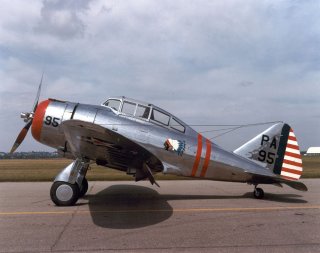The Seversky P-35 Was the F-35 Of World War II
The fifth-generation Lockheed Martin F-35 Lightning II Joint Strike Fighter has been noted for being a major leap forward in aviation design, and long before that aircraft took flight there was the Seversky P-35, an aircraft that was the forerunner of the Republic P-47.
The fifth-generation Lockheed Martin F-35 Lightning II Joint Strike Fighter has been noted for being a major leap forward in aviation design, and long before that aircraft took flight there was the Seversky P-35, an aircraft that was the forerunner of the Republic P-47.
Developed in the early 1930s, the aircraft was actually a contemporary of the U.K.'s Hawker Hurricane and Germany's Messerschmitt Bf 109 and was the first United States Army Air Corps (USAAC's) single-seat fighter to feature all-metal construction, retractable landing gear, and an enclosed cockpit. It might not have been stealth, but in the 1930s it was truly an innovative aircraft.
It was developed as part of a collaborative effort between Alexander P. de Seversky and Alexander Kartveli of The Seversky Aircraft Corporation, and it was derived from the Seversky SEV-3, which had set a record for piston-engine amphibious aircraft reaching 230 mph.
The P-35 was powered by a single Pratt & Whitney R-1830 engine that provided 850 horsepower and gave the aircraft a maximum speed of 280 mph and a cruising speed of 260 mph. It was armed with both a .50 caliber machine gun and a .30 caliber machine gun mounted in the fuselage, and it could carry up to 320 pounds of bombs.
The USAAC accepted seventy-six of the P-35s in 1937 and 1938 and assigned all but one of those aircraft to the 1st Pursuit Group, which was based at Selfridge Field, Michigan. When the P-35 was introduced in 1937 at a highly publicized event, it was presented as an aircraft that would provide the United States military with aerial superiority over any potential adversary. However, such boast greatly exaggerated the P-35's capabilities, and the aircraft's actual performance was considered poor by contemporary standards and it was essentially obsolete by the time the final aircraft were delivered – although USAAC aviators found the plane's ruggedness to be its greatest attribution.
Due to production delays, the USAAC opted to purchase 210 Curtiss P-36 Hawks. Matters were made worse by the fact that Seversky sold twenty of the two-seat fighter-bomber 2PA variant to the Imperial Japanese Navy in 1939 – and those became the only American-built aircraft used operationally by the Japanese during World War II.
As a result, the Seversky Aircraft Corporation ended up looking to export the remainder of the 196 P-35s that were built. Alexander P. de Seversky even headed to Europe to find a buyer for the aircraft but only Sweden placed an order. While originally one hundred and twenty were ordered, only sixty of the improved variant, designated the EP-106, were eventually delivered due to a June 1940 U.S. embargo of aircraft sales to Europe other than to Great Britain.
Instead many of the final batch of P-35s were sent to the Far East Air Force in the Philippines beginning in February 1941, and those aircraft didn't fare well against the Japanese fighters in the early stages of America's entry into World War II. All were lost in action, and as for Seversky he was fired from the company by the board of directors and the company was rebranded Republic Aviation – and it went on to create the truly revolutionary P-47 Thunderbolt.
A handful of P-35s eventually saw service with the Colombian Air Force and the Ecuadorian Air Force and most that were destroyed in combat during the war simply rusted away. Today there are three original surviving aircraft including one at the Swedish Air Force Museum; one at the Planes of Fame Air Museum at the Chino Airport, California; and one in the collection of the National Museum of the United States Air Force in Dayton, Ohio.
Peter Suciu is a Michigan-based writer who has contributed to more than four dozen magazines, newspapers, and websites. He regularly writes about military small arms and is the author of several books on military headgear including A Gallery of Military Headdress, which is available on Amazon.com.

